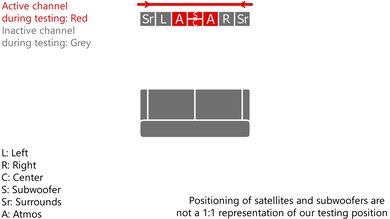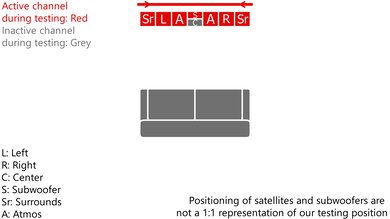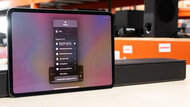The Sennheiser AMBEO Soundbar Plus is a standalone soundbar released in 2022. It's a smaller and more affordable version of the Sennheiser AMBEO Soundbar MAX, offering a cinematic sound in a standalone soundbar setup. Like the MAX, the bar supports many different audio formats, including Dolby Atmos and DTS:X, though it adds built-in voice assistant support for those who want to control the bar with their voice. With the AMBEO 3D feature, you can upmix stereo content to virtual surround using one of the bar's three presets: Light, Standard, and Boost.
Note: The manufacturer advertises this bar as a 7.1.4 setup. However, after testing the bar, we have determined that it is physically more in line with a 5.1.2 soundbar. It has surround channels on each side, along with left and right stereo channels and a center channel. There are also two up-firing drivers and the integrated dual subwoofers. Our impressions appear to be confirmed by an exploded view of the bar's setup found on the manufacturer's website. The bar is marketed to use its room correction technology to position seven "virtual" speakers around you and four overhead, which is likely why it's advertised in this way.
Our Verdict
The Sennheiser AMBEO Soundbar Plus is good for mixed usage. This premium setup has a solid build and supports lots of different audio formats that you're likely to come across on different streaming platforms and Blu-rays. With its AMBEO 3D mode, you get an expansive surround sound, and it does a decent job with Atmos content for a standalone bar. Without a dedicated sub, it lacks thump and rumble in bass-heavy music and action-packed movies.
- Graphic EQ and presets.
- Dolby Atmos support.
- Lacks low-bass.
The Sennheiser AMBEO Soundbar Plus is great for dialogue-centric content like TV shows and podcasts. Its discrete center channel improves overall vocal reproduction, so dialogue sounds clear and present in the mix. There's a dialogue enhancement tool on hand, too, if you want to make voices more crisp. Plus, podcasts and audiobooks are easy to stream right to the bar over a wireless connection.
- Dialogue enhancement tool.
- High latency via HDMI.
The Sennheiser AMBEO Soundbar Plus is decent for music. It comes with a room correction feature that automatically adjusts the bar's sound based on the unique acoustics of your room. However, since it lacks a dedicated subwoofer, it can't reproduce the deep rumble in the low-bass that's commonly found in bass-heavy genres like EDM and hip-hop. Overall, its sound profile is fairly neutral, with a touch of extra brightness due to the lack of bass. You can adjust its output if you wish, using the graphic EQ and presets available in its companion app.
- Graphic EQ and presets.
- Lacks low-bass.
The Sennheiser AMBEO Soundbar Plus is good for movies. It supports 5.1 surround sound formats like Dolby Digital as well as lossless and object-based formats like Dolby Atmos, which you're likely to find on lots of different streaming services. Its virtual surround mode, called AMBEO 3D, brings an additional richness to audio. It offers a pretty immersive listening experience for a standalone bar; however, it lacks rumble in the low-bass and can't replicate height with the same accuracy as other setups.
- Dolby Atmos support.
- Lacks low-bass.
Changelog
- Updated Aug 21, 2024: This review has been updated to mention the Sony BRAVIA Theater Bar 8 in Video Passthrough to TV.
- Updated May 21, 2024: Per TBU 1.3 methodology, we updated the text in the Stereo Sound boxes after retesting with the manufacturer's recommended settings. Also added text to Audio Latency: ARC, Audio Latency: HDMI In, and Audio Latency: Optical boxes. Some updates to the usages as well, in line with these changes.
- Updated May 16, 2024: We've converted this review to Test Bench Update 1.3. If applicable, we've retested stereo sound based on the manufacturer's recommendations. Additionally, we've expanded our audio latency tests to the following boxes: Audio Latency: ARC, Audio Latency: HDMI In, and Audio Latency: Optical. You can see the full changelog here.
- Updated Dec 12, 2023: Added market comparison with the Sennheiser AMBEO Soundbar Mini in the Dimensions - Bar box.
Check Price
Differences Between Sizes And Variants
The Sennheiser AMBEO Soundbar Plus is available in Black. You can see the label for the model we tested here.
If you come across another version of this soundbar, let us know in the discussions, and we'll update the review.
Popular Soundbar Comparisons
The Sennheiser AMBEO Soundbar Plus is a standalone bar that's smaller than the Sennheiser AMBEO Soundbar MAX. It supports many different audio formats and offers a lot of the same customization tools as the MAX, with added support for voice assistants built into the bar itself. That said, it doesn't bring the same punch with immersive audio formats, especially Atmos content, and you don't get the same feeling of height.
You can also check out our recommendations for the best soundbars, the best standalone soundbars, and the best Dolby Atmos soundbars.
The Sonos Arc and the Sennheiser AMBEO Soundbar Plus are both very premium standalone soundbars with Dolby Atmos support. The Sonos has a wider, more immersive soundstage, which is especially noticeable with Atmos content. However, it doesn't come with HDMI In ports like the Sennheiser, and it doesn't support as many wireless playback options like Bluetooth.
The Sennheiser AMBEO Soundbar MAX is better than the Sennheiser AMBEO Soundbar Plus. The MAX is a bigger setup with a lot more rumble in the bass, which is great for action-packed movies and bass-heavy music genres. Both bars support many audio formats and offer similar sound enhancement features, but the MAX's large design brings a more cinematic sound, especially with Atmos content. However, it doesn't have built-in voice assistant support like the Plus.
The Sennheiser AMBEO Soundbar Plus is better than the Sennheiser AMBEO Soundbar Mini. As you can guess from their names, the Mini is a smaller, more compact bar better suited for smaller spaces. However, its soundstage and center channel performances aren't as good as the Plus. The Plus also has more connectivity options, notably a Full HDMI In port for video passthrough.
The Bose Smart Soundbar 900 and the Sennheiser AMBEO Soundbar Plus are premium Dolby Atmos soundbars. The Bose's sound quality is superior, as it has a better soundstage that creates a more immersive listening experience. It's especially noticeable with Atmos content. However, it can't do video passthrough like the Sennheiser since it lacks an HDMI In port.
Test Results

The bar is rather wide, so it doesn't fit between the legs of most 55" TV stands. It isn't very tall, either, so it won't block your TV screen unless your TV sits flush on your table. If you want a similar bar that takes up less room, check out the Sennheiser AMBEO Soundbar Mini.
The Sennheiser AMBEO Soundbar Plus has great build quality. It's mostly made of plastic, which feels very sturdy and solid. The grilles on top of the bar are designed to protect the drivers inside. The fabric wrapping around the sides has a tight fit, so it isn't likely to rip easily. Still, it might collect some dust and debris over time.
The Sennheiser AMBEO Soundbar Plus has a decent stereo frequency response. Its low-frequency extension isn't as impressive as other bars with dedicated subwoofers, so there isn't as much thump and rumble in the bass range to bring bass-heavy genres like EDM to life. Its overall sound profile is fairly balanced but slightly bright. Voices and lead instruments are clearly reproduced, and they seem to sparkle due to the extra emphasis in the treble.
Note: We tested the bar after running the room correction feature. Its AMBEO 3D virtual surround mode was set to Regular to mimic a typical listening experience. When you play stereo files with this feature, the bar upmixes the content, so you hear audio from all channels except the center.
The Sennheiser AMBEO Soundbar Plus doesn't come with bass or treble adjustments. However, the companion app has a four-band graphic EQ for each preset. We used the Foundation band to adjust the bass, which you can see here. With an additional two decibels added, the bar's sound is a bit more balanced with stereo content. Voices and lead instruments in your favorite tunes are still clearly reproduced, and you get a touch of extra punch in the bass. However, the EQ can't add to the low-frequency extension, so the deep rumble in the low-bass is still missing.
The Sennheiser AMBEO Soundbar Plus has a good stereo soundstage. Its soundstage is perceived to be a bit wider than the bar itself, which is nice. Also, it has good focus, so it's easy to pinpoint sound effects to an accurate location in the mix. For example, if you listen to an orchestral recording, each instrument seems to come from the same location it would on the stage.
The Sennheiser AMBEO Soundbar Plus gets loud, so you won't have trouble filling larger and more open spaces with sound. As you crank up the volume, there's a bit of compression and pumping artifacts present that distort the sound, but it's not too major.
The bar's discrete center channel is designed to improve vocal reproduction. Its frequency response is even and balanced, albeit a touch on the bright side due to the lack of bass. As a result, dialogue reproduces with clarity, and you don't have any trouble following along with the action on screen.
The bar performs okay with 5.1 surround content when using its AMBEO 3D mode. Content plays from the side-firing and front-firing speakers on the bar, as well as the up-firing drivers. For a phantom localization, it does well, so sound effects seem to stretch into the space around you. However, it doesn't seem as real-to-life as a setup with discrete surround speakers.
With its AMBEO 3D mode turned on, the bar is a fair choice for height content like Dolby Atmos. It uses its side-firing and up-firing drivers to simulate height in the space around you. The frequency response on these channels is fairly even but a touch bright due to the lack of bass.
Subjectively, the bar's soundstage with Atmos content is just okay. Sound stretches wide into the space around you, aided by the AMBEO 3D mode. However, you don't notice sound effects in the space above you or behind you, which takes away from the overall immersive feel. Details are a bit diffused at times, too, as the volume is high on some effects and low on others.
The Sennheiser AMBEO Soundbar Plus offers a lot of sound enhancement features. There's a room correction tool that optimizes its audio reproduction based on the unique acoustics of your room. Also, it comes with a virtual surround feature called AMBEO 3D, which you can set to one of three different intensity levels: Light, Regular, and Boost. Subjectively, we found that audio sounds richer with the AMBEO 3D mode turned on.
You can also customize its sound to your liking. There aren't traditional bass and treble adjustments, but the app has four-band graphic EQs with each preset: Adaptive, Music, Movie, News, Neutral, and Sports. Through the equalizers, you can adjust the bass, the mids, and the treble, which is handy.
You can connect the bar to your TV over Optical or HDMI connections. The two HDMI In ports are great if you want to use the bar as a hub between different devices, like your TV and your PC. You can even add an external subwoofer to your setup using the blue RCA input. The USB input is only for firmware updates, so you can't use it to playback audio files.
The bar supports lots of different audio formats that you're likely to come across on both streaming platforms and Blu-rays discs. It can playback 5.1 surround sound formats like Dolby Digital as well as lossless and object-based formats like Dolby Atmos.
The Sennheiser AMBEO Soundbar Plus supports the most advanced sound formats via HDMI In. You can playback surround sound and object-based formats like Dolby Atmos or lossless formats like PCM 5.1. They're more and more commonly found with streaming services for both movies and TV shows.
Over Optical, the bar supports both Dolby Digital and DTS 5.1 surround sound formats.
This bar has mediocre latency via ARC. There's delay across all formats, which causes your audio and visuals to fall out of sync. While some apps and TVs compensate for latency, a lip-sync tool in the companion app lets you manually compensate for delay.
Latency is also pretty high via HDMI: In. The audio you hear isn't well-synched with the video you see on the screen. However, a lip-synching tool in the bar's companion app lets you adjust the delay, which can help if you run into issues. Some apps and TVs compensate for delay, though.
This bar has a significantly better latency performance when connected via Optical. Your audio and visuals are in sync, but you can additionally adjust for delay manually using the companion app's dedicated lip-sync control.
The bar can passthrough some of the highest-quality bandwidth signals, including Dolby Vision Passthrough. That said, it can't do 4k at 120Hz, so if you're a gamer with a next-generation console, consider the Sony BRAVIA Theater Bar 8 for greater passthrough support.
You can stream audio wirelessly to the bar over lots of different connections. The manufacturer says that you can connect to the bar over music services like Spotify, Amazon Music, Tidal, and TuneIn in the future.


































